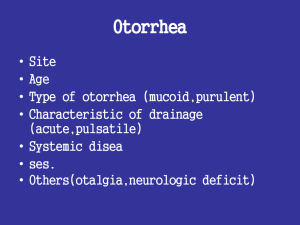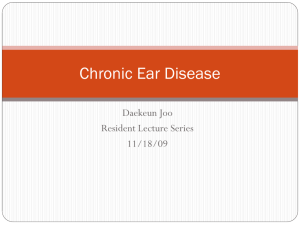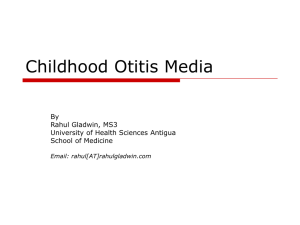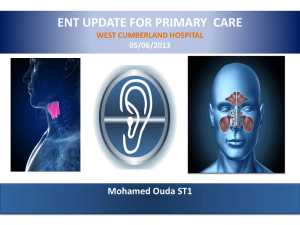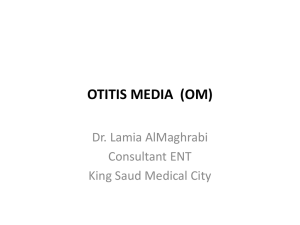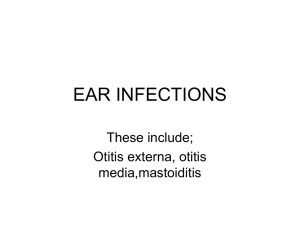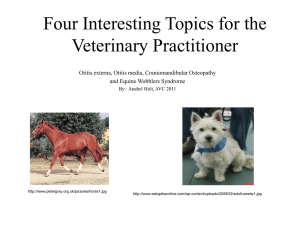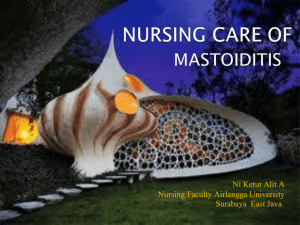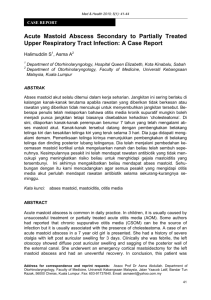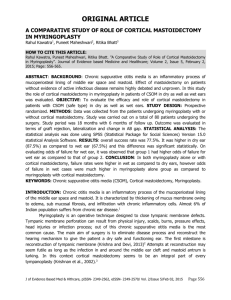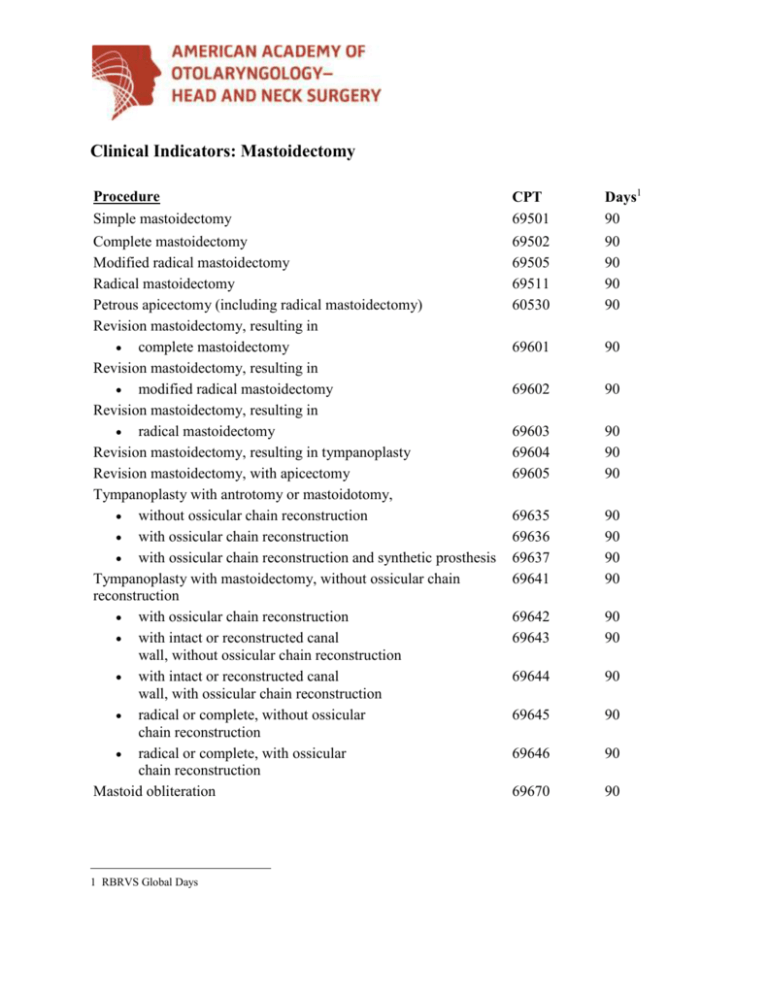
Clinical Indicators: Mastoidectomy
Procedure
Simple mastoidectomy
CPT
69501
Days1
90
Complete mastoidectomy
Modified radical mastoidectomy
Radical mastoidectomy
Petrous apicectomy (including radical mastoidectomy)
Revision mastoidectomy, resulting in
complete mastoidectomy
Revision mastoidectomy, resulting in
modified radical mastoidectomy
Revision mastoidectomy, resulting in
radical mastoidectomy
Revision mastoidectomy, resulting in tympanoplasty
Revision mastoidectomy, with apicectomy
Tympanoplasty with antrotomy or mastoidotomy,
without ossicular chain reconstruction
with ossicular chain reconstruction
with ossicular chain reconstruction and synthetic prosthesis
Tympanoplasty with mastoidectomy, without ossicular chain
reconstruction
with ossicular chain reconstruction
with intact or reconstructed canal
wall, without ossicular chain reconstruction
with intact or reconstructed canal
wall, with ossicular chain reconstruction
radical or complete, without ossicular
chain reconstruction
radical or complete, with ossicular
chain reconstruction
Mastoid obliteration
69502
69505
69511
60530
90
90
90
90
69601
90
69602
90
69603
69604
69605
90
90
90
69635
69636
69637
69641
90
90
90
90
69642
69643
90
90
69644
90
69645
90
69646
90
69670
90
1 RBRVS Global Days
Indications
1. History (One or more required)
a) Postauricular periosteal swelling or pain unresponsive to
medical treatment.
b) Infected drainage from the ear unresponsive to medical
treatment.
d) Planned second look for intact wall mastoidectomy.
e) Persistent middle ear disease unresponsive to management.
f) Fullness in the ear, hearing loss or pain.
g) Approach to failed tympanoplasty.
h) Evidence of chronic disease in patient who may not be aware of
a problem such as retraction pockets with squamous debris,
cholesteatoma, mucous crusts from non-infected discharge, and
glomus tympanicum.
2. Physical Examination (required)
a) Complete bilateral description of ear canal, tympanic
membrane, postauricular area (if abnormal), facial nerve
function and description of nystagmus (if present).
b) Description of middle ear.
c) Description of gross hearing.
3. Tests
a) Audiometry--pure tone and speech bilateral.
b) Imaging--CT scan optional.
Postoperative Observations
a)
b)
c)
d)
e)
f)
Bleeding.
Facial weakness.
Dizziness.
Mental status.
Pain.
Dressing.
Outcome Review
1. One Week
a) Incision and cavity--Is there evidence of infection?
b) Inner ear and facial nerve--Is there dizziness or facial weakness?
2. Beyond Two Months
a) Hearing--document with audiogram.
b) Tympanic membrane--Status of TM if tympanoplasty done.
c) Mastoid cavity--Is it healed and dry?
d) Infection--If this was the reason for surgery, has it been
controlled?
Associated ICD-9 Diagnostic Codes (Representative, but not all inclusive codes)
1) Nonsuppurative otitis media and eustachian tube disorder
381.0 Acute nonsuppurative otitis media
381.00 Acute nonsuppurative otitis media, unspecified
381.01 Acute serous otitis media
381.02 Acute mucoid otitis media
381.03 Acute sanguinous otitis media
381.04 Acute allergic serous otitis media
381.05 Acute allergic mucoid otitis media
381.06 Acute allergic sanguinous otitis media
381.1 Chronic serous otitis media
381.10 Chronic serous otitis media, simple or unspecified
381.19 Other: Serosanguinous chronic otitis media
381.2 Chronic mucoid otitis media
381.20 Chronic mucoid otitis media, simple or unspecified
381.29 Other: Mucosanguinous chronic otitis media
381.3 Other unspecified chronic nonsuppurative otitis media
381.5 Eustachian salpingitis
381.50 Eustachian tube salpingitis, unspecified
381.51 Acute eustachian salpingitis
381.52 Chronic eustachian salpingitis
381.6 Obstruction of eustachian tube
381.60 Obstruction of eustachian tube, unspecified
381.61 Osseous obstruction of eustachian tube
381.62 Intrinsic cartilagenous obstruction of eustachian tube
381.63 Extrinsic cartilagenous obstruction of eustachian tube
381.8 Other disorders of eustachian tube
381.81 Dysfunction of eustachian tube
2) Suppurative and unspecified otitis media
382.0 Acute suppurative otitis media
382.00 Acute suppurative otitis media without spontaneous rupture
of ear drum
382.01 Acute suppurative otitis media with spontaneous rupture of
ear drum
382.02 Acute suppurative otitis media in diseases classified
elsewhere
382.1 Chronic tubotympanic suppurative otitis media
382.2 Chronic atticoantral suppurative otitis media
3) Mastoiditis and related conditions
383.00 Acute mastoiditis without complications
383.01 Subperiosteal abscess of mastoid
383.02 Acute mastoiditis with other complications
383.1 Chronic mastoiditis
383.2 Petrositis
383.20 Petrositis, unspecified
383.21 Acute petrositis
383.22 Chronic petrositis
383.3 Complications following mastoidectomy
383.30 Postmastiodectomy complication, unspecified
383.31 Mucosal cyst of postmastoidectomy cavity
383.32 Recurrent cholesteatoma of postmastoidectomy cavity
383.33 Granulations of postmastoidectomy cavity
383.8 Other disorders of mastoid
383.81 Postauricular fistula
4) Other disorders of middle ear and mastoid
385.3 Cholesteatoma of middle ear and mastoid
385.30 Cholesteatoma, unspecified
385.31 Cholesteatoma of attic
385.32 Cholesteatoma of middle ear
385.33 Cholesteatoma of middle ear and mastoid
385.35 Diffuse cholesteatosis
385.8 Other disorders of middle ear and mastoid
385.82 Cholesterin granuloma
Additional Information
Assistant Surgeon -- Y
Supply Charges -- N
Prior Approval -- N
Anesthesia Code(s)—00210; 00124; 00126
Patient Information
Mastoidectomy is an operation to remove disease from the bone behind the ear, when medical
management is inadequate. Sometimes a mastoidectomy is required in order to gain better exposure
to the disease. Although complications do not often occur, they include persistent ear drainage,
infection in the mastoid cavity, and hearing loss. Weakness of the face on the side of the surgery is a
rare but potential hazard in mastoid surgery. There may be dizziness for a short time after surgery,
but it is rarely permanent. Loss of taste on the side of the tongue may occur and last a few weeks,
but may be permanent.
Important Disclaimer Notice
Clinical indicators for otolaryngology serve as a checklist for practitioners and a quality care review
tool for clinical departments. The American Academy of Otolaryngology—Head and Neck Surgery,
Inc. and Foundation (AAO-HNS/F) Clinical Indicators are intended as suggestions, not rules, and
should be modified by users when deemed medically necessary. In no sense do they represent a
standard of care. The applicability of an indicator for a procedure must be determined by the
responsible physician in light of all the circumstances presented by the individual patient.
Adherence to these clinical indicators will not ensure successful treatment in every situation.
The AAO-HNS/F emphasizes that these clinical indicators should not be deemed inclusive of all
proper treatment decisions or methods of care, nor exclusive of other treatment decisions or methods
of care reasonably directed to obtaining the same results. The AAO-HNS/F is not responsible for
treatment decisions or care provided by individual physicians.
CPT five-digit codes, nomenclature and other data are copyright 2009 American Medical
Association. All Rights Reserved. No fee schedules, basic units, relative values or related listings
are included in CPT. The AMA assumes no liability for the data contained herein.
© 2010 American Academy of Otolaryngology-Head and Neck Surgery. 1650 Diagonal Road,
Alexandria, VA 22314.

